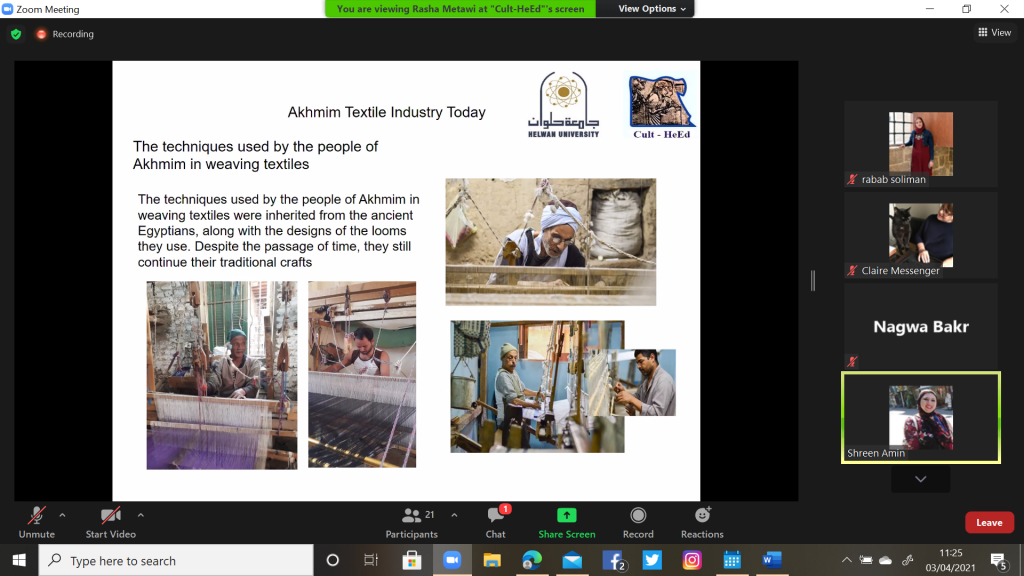Engaging With Local Communities to Safeguard Egypt’s Intangible Cultural Heritage
Written by Claire Messenger, International Training Programme Manager
On Saturday 3 April I was delighted to join colleagues in Cairo at a webinar organised by Helwan University Cultural Heritage Training and Education Center (Cult-HeEd). The session focussed on engaging with local communities to safeguard Egypt’s intangible cultural heritage and was a fascinating and insightful overview of some of the projects and programmes happening across the country.
The webinar started with a welcome, introduction and overview of the session by Professor Dr. Rasha Mutawa, Director of the Centre. Here she introduced one of the faculties projects, Know the heritage of your governorate and share it with us. This excellent project allows colleagues across the sector to share, record and document the living heritage of Egypt through local communities. The questionnaire was easy to use, captures all the necessary information and usefully, was downloadable so it could be taken into the field and completed with the community – no need to consider internet access and equipment!!

The next session ‘Community and Intangible Heritage: The Dynamics of Unconventional Relationship’ was with Dr Riham Arram. Riham’s excellent session looked at one common factor across all community projects – that communities are the creators and curators of their intangible heritage. She used a lovely phrase describing communities as the ‘practitioners and savers’ of their heritage and as such are of huge importance to any project to capture and preserve local cultures and practices. If the community does not recognise it’s intangible cultural heritage it cannot – and should not – be forced to. For any relationship between museums and communities to be fruitful, it must be mutual and respectful.


Riham also shared views on the important impact of protecting and sharing intangible cultural heritage. She considered three aspects of impact – social where intangible heritage can be used to improve inclusion, understanding, wellbeing and cohesion; economic which can support tourism, jobs and investment potentially leading to greater economic prosperity and environmental which can aid preservation and greater sustainability.
Useful resource – UNESCO 2003 Convention for the Safeguarding of the Intangible Cultural Heritage.
https://ich.unesco.org/en/convention
The session moved on to presentations from two of our International Training Programme network colleagues – Shreen Amin, Director of the Children’s Museum at the Egyptian Museum in Cairo (Egypt, ITP Fellow 2016) and Nagwa Bakr, Community Engagement Officer at the Ministry of Tourism and Antiquities (Egypt, ITP Fellow 2019) who shared case studies to share examples of the work being done with communities in Egypt to preserve and promote intangible cultural heritage.

Shreen’s session on ‘The rich cultural heritage of Akhmim: traditional hand-woven textiles’ looked at the tradition of textile manufacturing in the city of Akhmim, in Upper Egypt. Shreen gave an overview of the area and its history, then focussed on the long tradition of weaving in the city, mentioned as early as the fifth century BCE by the Greek historian Herodotus. The session highlighted the work currently being done by the local community in the textile industry today looking specifically at techniques, equipment, design, motifs and patterns and asked the question what could be done to support this industry and preserve the knowledge, skills and experiences so important to the cultural identity and economy of the area.
Useful resource – UNESCO Handmade weaving in Upper Egypt (Sa’eed).
https://ich.unesco.org/en/USL/handmade-weaving-in-upper-egypt-sa-eed-01605
Shreen kindly shared the video of her visit to meet hand-loom weavers in Akhmim here and her PPT here.
Nagwa’s session on ‘The Smithsonian Folk Life Festival and the Palm Trees Festival in Cairo’ gave an overview of the inspiration behind a project delivered in Cairo in 2018 to enable cultural practitioners to speak for themselves.
The Smithsonian Folk Life Festival, which began in 1967, aims to ‘collaborate with cultural practitioners, communities, and heritage professionals to spark curiosity, catalyze intercultural exchange, and create participatory experiences that nurture human connection’. This takes place, annually, and through musicians, artists, crafts people, cookery and performances amongst many other practitioners, has the purpose to increase knowledge and share experiences.

Taking inspiration from this project, the Palm Trees Festival in Cairo looked to share and promote the industries and crafts created by and from palm trees in Egypt. The aims of the project were to increase awareness of the significance and benefits of palm trees; to build a network of those communities who create crafts and share stories around palm trees and their products and create programmes to support the continuity of these cultural heritage practices and traditions. Nagwa shared very useful information around the partnerships, opportunities, and challenges around the project. She also focussed on some of the outputs including visits to palm tree farmers, workshops for women and sharing stories and activities in primary schools.
Useful resource – The Smithsonian Folk Life Festival https://festival.si.edu/
Nagwa kindly shared report and documentation from the Palm Trees Festival:
